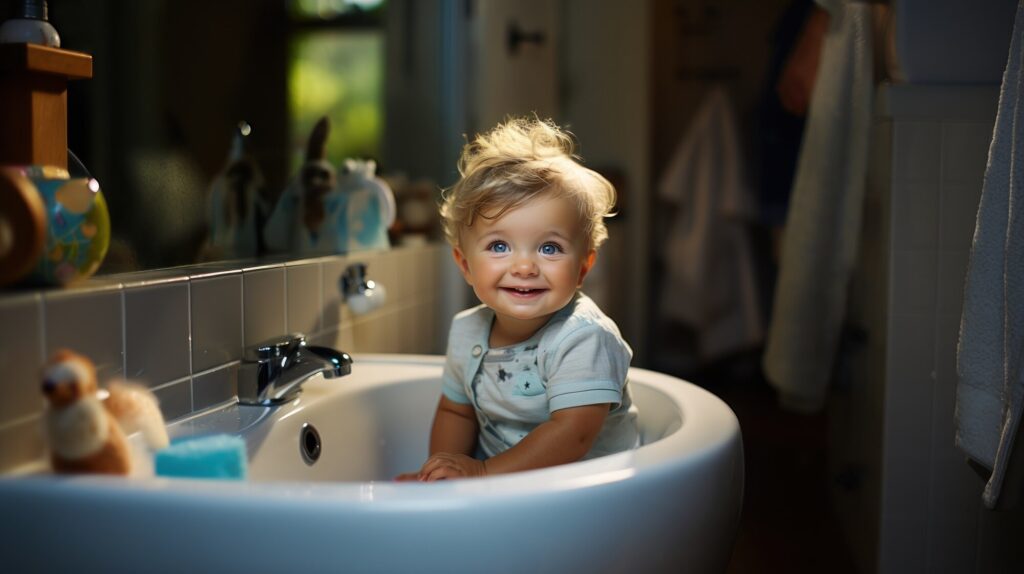I frequently get asked, “Can I bathe my baby in the sink?” To be fair, it’s a question we questioned ourselves when our own kids were little, and it’s likely that our parents did too! In order to put an end to this dispute, we thought we’d offer you the lowdown on sink baths for babies—what to consider, why you should attempt them, and should you do so at all!
Why bathe your baby in the sink?
There are a lot of reasons why new parents would think about giving their infant a sink bath. When a new baby is brought home, some families might not have access to a baby bath or may only have a shower in their bathroom. It’s possible that some families are just carrying on a multigenerational tradition!

Because there was no other option, many families would bathe their babies in the sink prior to the nursery industry’s development (and long before there were so many new baby essentials to add to your shopping lists!). Although there are many infant bath tubs available these days, many parents still believe that sink baths are more practical—after all, if it suits you, then why not?
Bathing your baby in the sink vs a baby bath
It could be a good idea to weigh the benefits and drawbacks of both options if you’re unsure whether to fill the sink or give your infant a bath.
Use less water
Because you have less area to work with, sink baths typically consume less water, which is a big benefit for many. This will not only result in lower water bills, but it will also benefit the environment greatly.
Easier on your back
Having to lean over a baby bath on the floor can be much more harmful to your back than standing at the sink. For this reason, sink baths can also be far more convenient for new mothers recovering from a c-section.
Quick and easy
Preparing everything for the baby bath tub takes a lot more time and effort than filling the sink for your baby’s bath. Additionally, you can arrange all of your equipment on the draining board so that it is more conveniently accessible.
Location is key
Many kitchen sinks are located near windows, which may not be the best arrangement during chilly months. One advantage of infant baths is that they may be moved to other areas of the house with water as necessary.
Not all sinks are sized the same
Designed for small babies to utilize, many baby bath tubs are generally the same size and form. You can have a larger, smaller, deeper, or shallower sink. Before you write off buying a tub, it’s important to consider the practicality of sink baths, as not all sinks are suitable for them.
Consider your cleaning products
We’ll talk more about cleaning your sink later, but for now, just know that you’ll need to clean it both before and after giving your baby a bath, so plan what cleaning supplies you’ll need.
Safety guidelines for sink baths
It’s vital to follow safety precautions, just as you would during a regular bath time, if you decide to give your infant a sink bath. Check out our bath safety rules here, and don’t forget to take the additional safety measures listed below:
- Make sure that the infant cannot access any culinary tools at any times.
- Store bath items somewhere different from where you store food.
- Avoid putting bath items on surfaces where food has been made.
- Instead, choose an occasion when the kitchen is empty.
Essential equipment for sink baths
If you decide to give your infant a sink bath, you will need a few key items, just like with a “regular” bath time. We advise:
- Wear the Cuddledry hands-free towel before you begin so that you’re prepared to go, and then wrap your baby in it afterwards.
- A bath insert to lower the risk of slipping and to keep your infant safe and secure
- A delicate bamboo cloth to shield the faucets
- A hamper filled with all the additional items required, such as a bath thermometer, clean underwear and diapers, feeding supplies, etc.
For more details on everything you need for baby bathtime, check out this post.
How to bathe your baby in the sink
All set to go? This is a very little guide that will show you how to do it correctly.
Clean the kitchen sink
Thoroughly cleaning the sink is the first step. This step cannot be ignored since, as you may recall, the majority of sink baths occur in the kitchen, where food is cooked and other cleaning supplies are utilized.
After giving the sink a thorough wash with cold water, add some baking soda to the bottom and all around the edges. Once the sink has been thoroughly cleaned, rinse it and proceed. As an alternative, you can use cleaning supplies that are safe for infants, just be sure to thoroughly rinse everything off after.
Washing your baby
You’re set to go once the sink is filled, the insert is in position, and the temperature has been checked.
- With one hand under your baby’s bottom and your forearm supporting their head and neck, you can gently and safely lower them into the water with the Cuddledry hands-free towel.
- To keep your infant warm, use the other hands to gently scoop water onto them.
- Give them a wash with a gentle bamboo washcloth.
- When you’re ready to hug, take the baby out of the sink and place them in your arms.
Upon completion, don’t forget to give the sink a thorough cleaning so that it’s prepared for future use.



